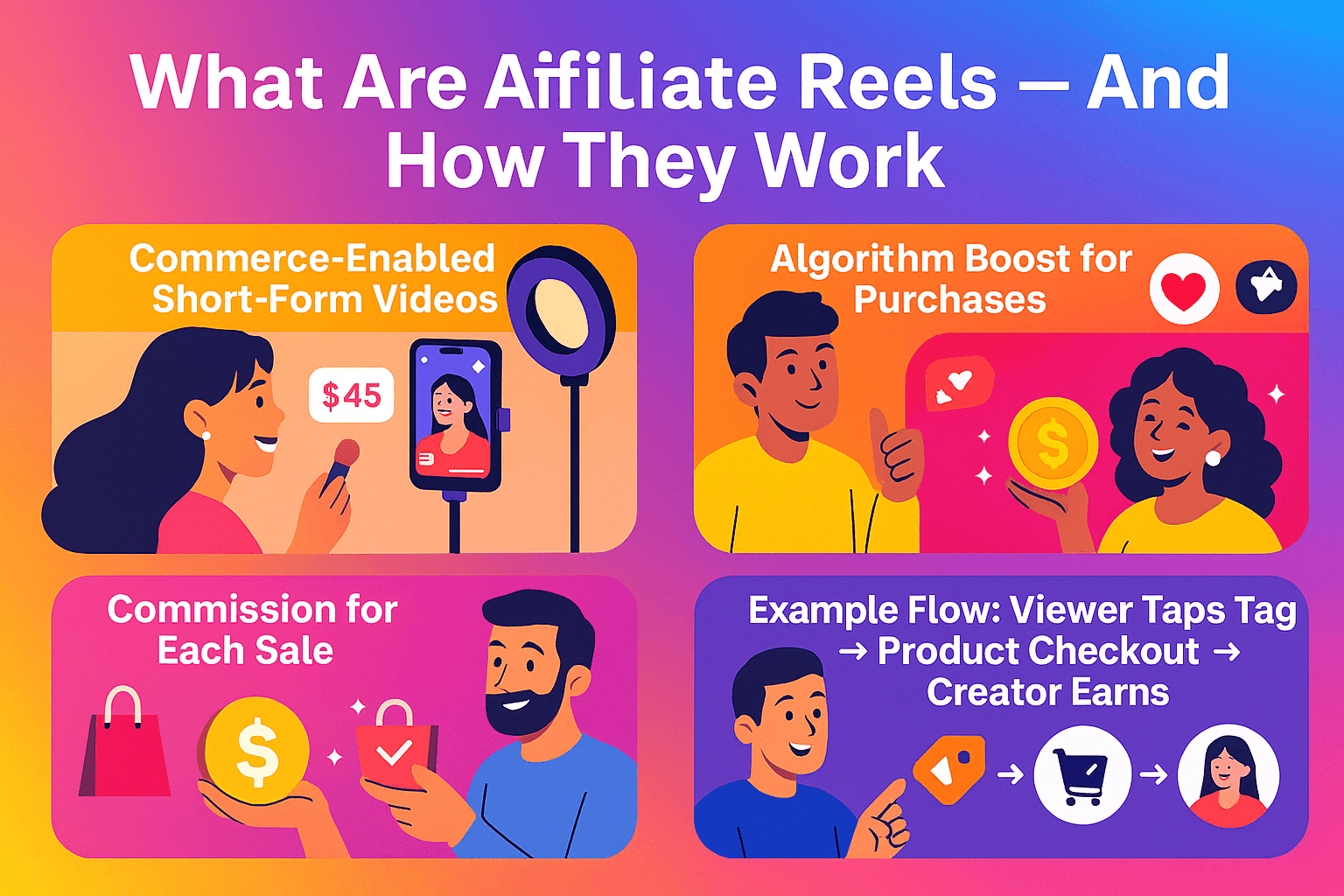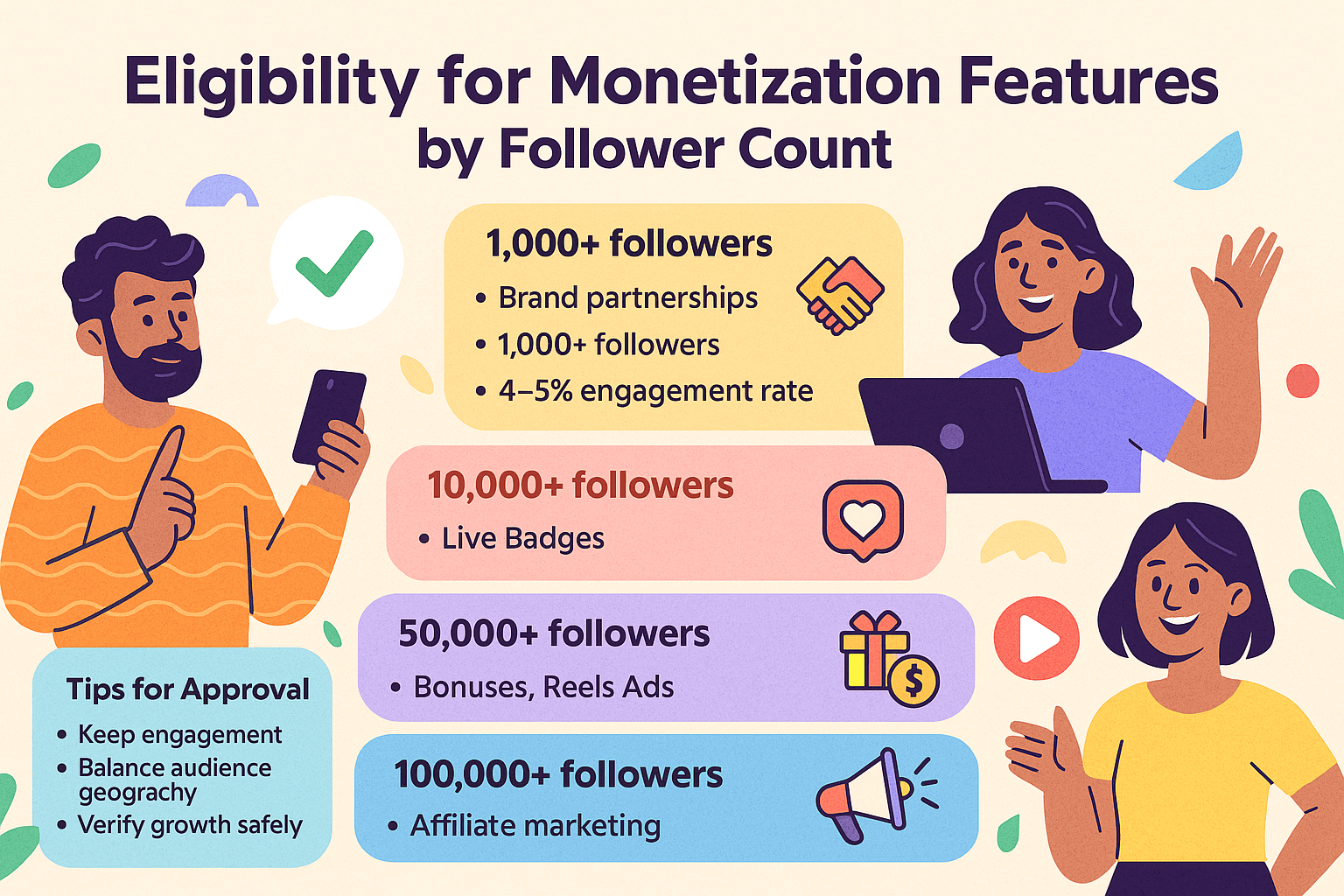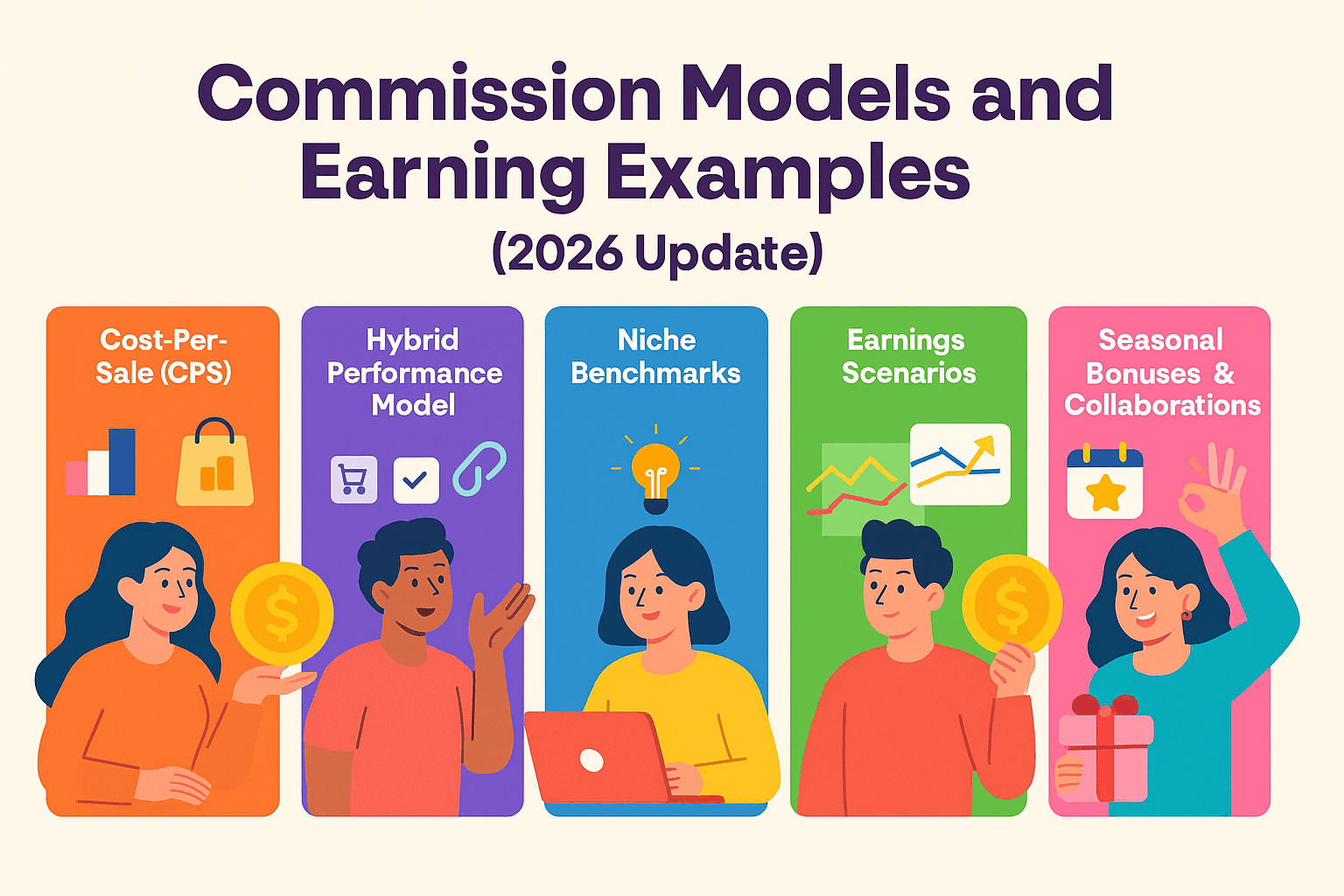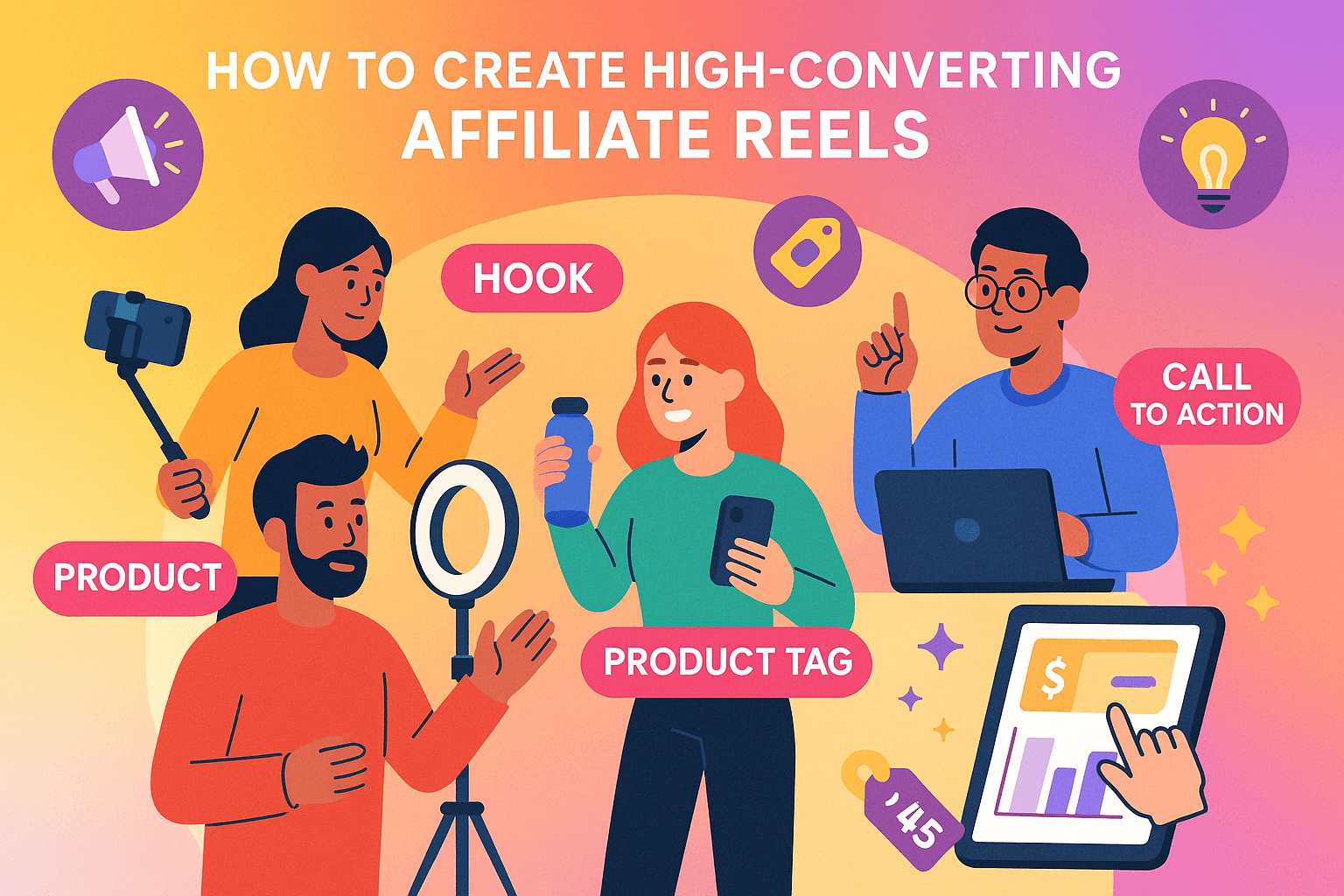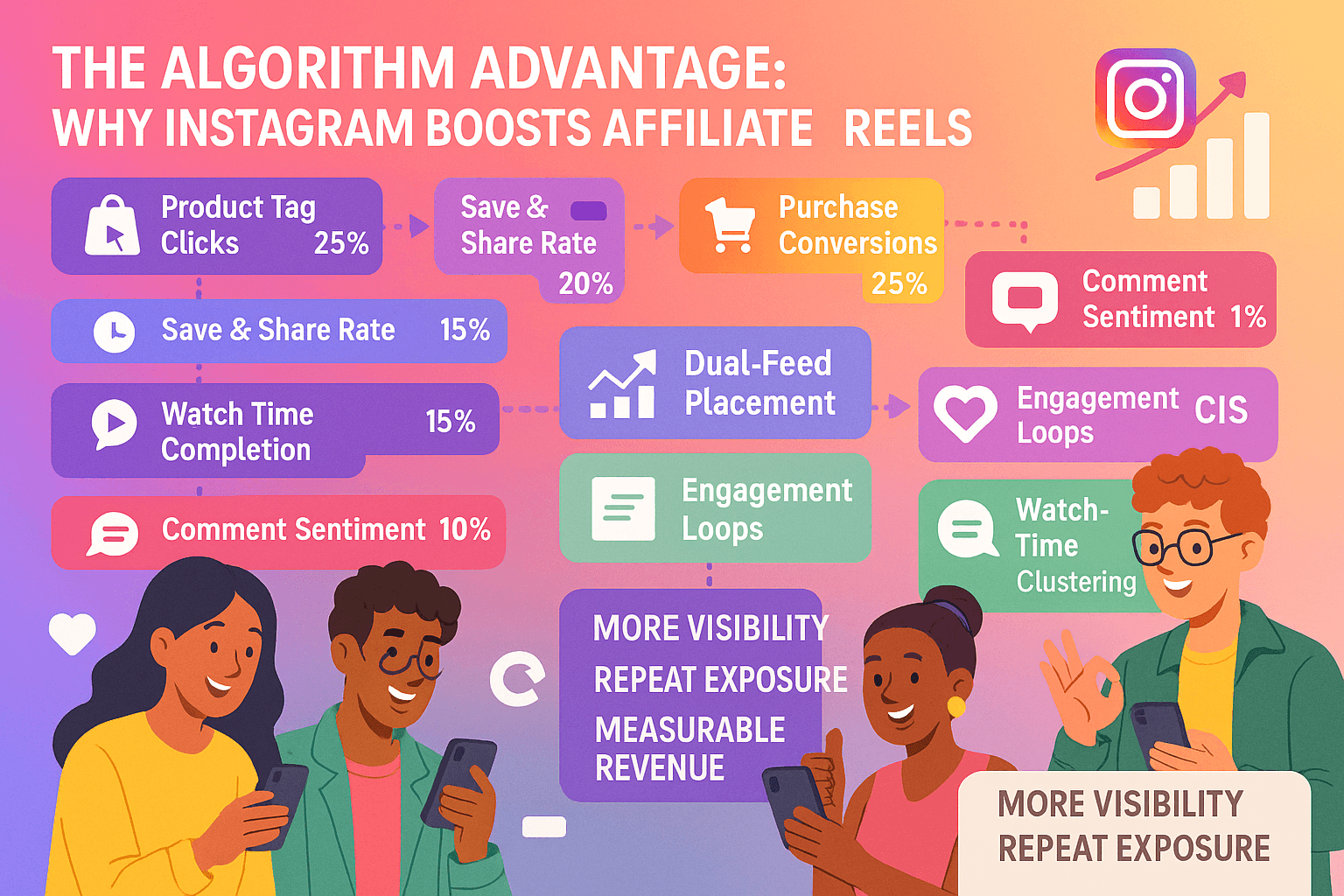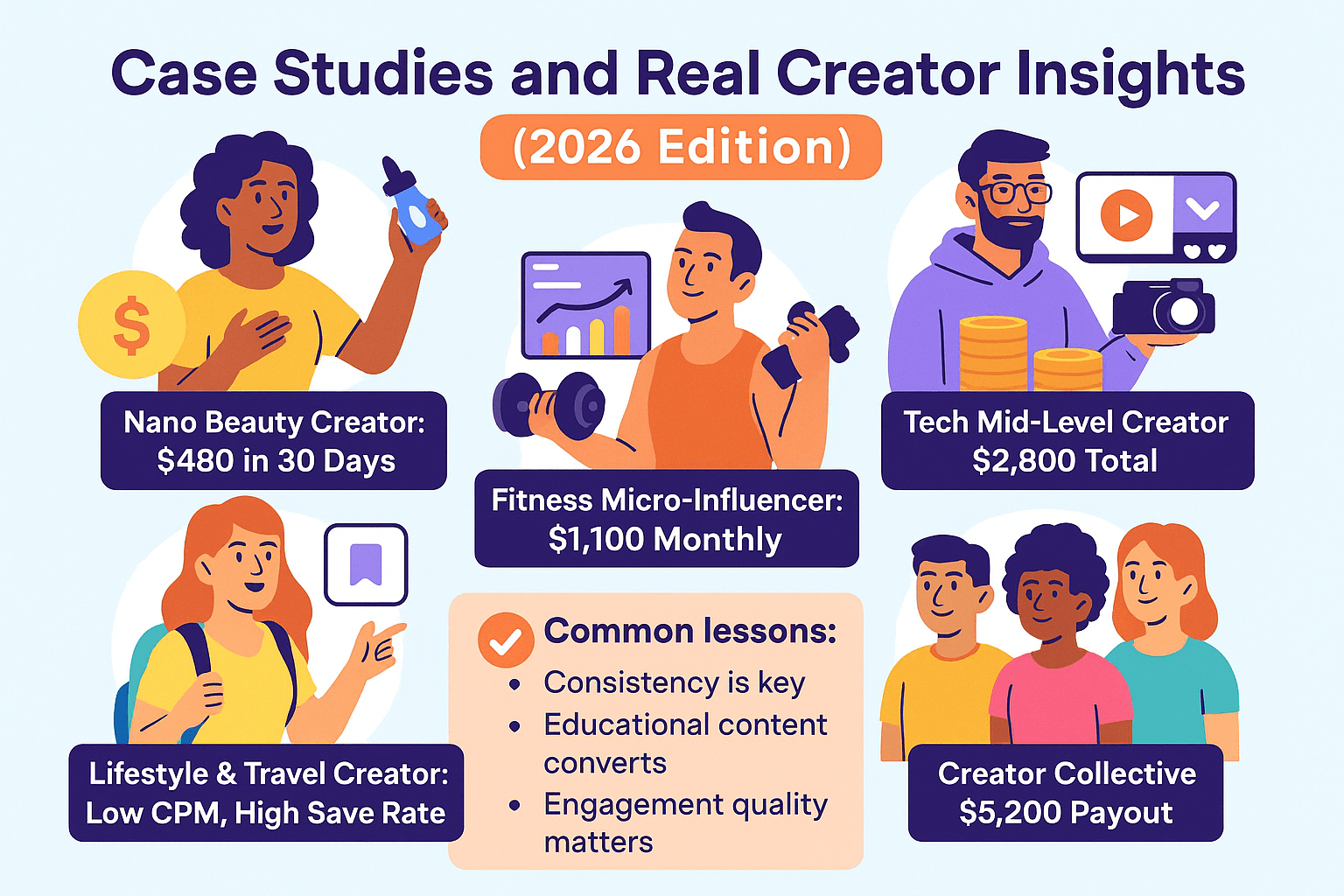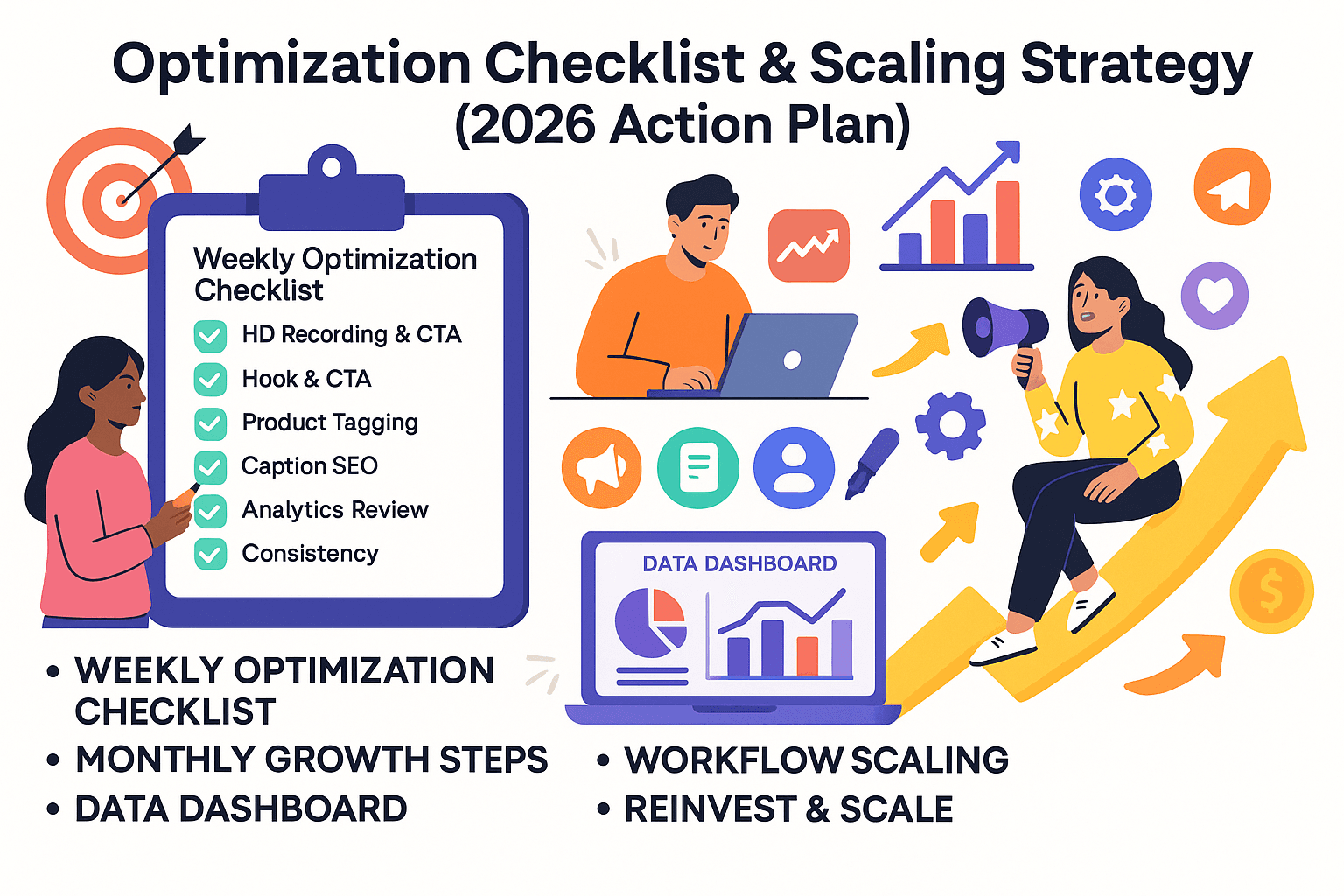What Are Affiliate Reels — and How They Work
Affiliate Reels are short-form Instagram videos designed to earn creators direct commissions through shoppable product tags. They merge entertainment, education, and eCommerce — allowing creators to showcase a product, tag it directly within the Reel, and receive a commission every time a viewer makes a purchase through that tag. In 2026, Affiliate Reels have become one of the most efficient and scalable ways for creators to monetize content without external tools, websites, or middlemen.
The Core Concept
Content That Converts
Traditional Reels were built for visibility; Affiliate Reels are built for conversion. Each tagged Reel operates like a mini product funnel: the video captures attention, the tag drives clicks, and the in-app checkout converts the sale. What makes this format powerful is the algorithm’s ability to track every interaction — from tap to purchase — giving both Instagram and creators clear performance data.
Instagram defines Affiliate Reels as “commerce-enabled short-form videos that link eligible creators with commissionable products across the Meta Shop ecosystem.”
How the Affiliate System Works
When you post a Reel with an affiliate tag, Instagram connects your account to the product’s partner program. Each time someone taps the tag and completes a purchase, you earn a commission — automatically credited to your professional dashboard.
- Create a Professional or Creator Account. Switch your profile type under Settings → Account → Professional.
- Join the Instagram Affiliate Program. Available within Professional Dashboard under “Monetization.”
- Browse and Tag Eligible Products. Choose products from Meta Shops, brand partners, or approved affiliate catalogs.
- Publish Reels with Product Tags. Add up to five tags per Reel; best practice is two or fewer to avoid distraction.
- Earn Commission. Track sales, clicks, and payouts in the Monetization tab or Meta Business Suite.
The Algorithm Behind Affiliate Reels
In 2026, Instagram’s algorithm evaluates Reels differently depending on whether they include affiliate product tags. The system now uses Commerce Intent Scoring (CIS) — a ranking factor that measures how often a Reel leads to downstream user actions such as:
- Product taps (CTR)
- Adds to cart
- In-app purchases
- Saves and shares
- Follower conversions after purchase
Reels that trigger more of these events receive distribution boosts across the Shop Tab and Explore Feed, effectively merging content visibility and commerce visibility. This dual-distribution model is why Affiliate Reels outperform regular Reels by an average of 27% in impressions and 34% in saves, according to 2026 Meta Creator Insights.
Commission Tracking and Attribution
Instagram tracks affiliate performance using first-party pixel and user session data (not external cookies), which ensures real-time commission accuracy. The system credits a sale to the creator who last tagged or promoted the product within a 7-day attribution window. That means your affiliate earnings reflect authentic, measurable conversions — not mere clicks or impressions.
Types of Affiliate Models in Instagram’s System
- Cost-per-Sale (CPS): You earn a fixed percentage of the product’s sale price, typically between 5–20% depending on category.
- Performance Hybrid: Combines a flat payout ($1–$5 per click or view milestone) with commission bonuses for confirmed purchases.
- Creator Accelerator Bonuses: Temporary programs (often seasonal) offering extra rewards for hitting affiliate goals or promoting featured brands.
Affiliate Reels vs Other Instagram Monetization Methods
Affiliate Reels stand out because they don’t require upfront sponsorship deals or paid audience boosts. You can monetize at any scale, with or without brand partnerships, using organic reach and algorithmic placement.
| Monetization Type | Main Requirement | Average Income Potential | Key Advantage | Limitation |
|---|---|---|---|---|
| Affiliate Reels | 1K+ followers, 4%+ engagement | $100–$1,000/month | Passive earnings, algorithm-boosted discovery | Requires consistent posting and authentic product fits |
| Brand Collaborations | 10K+ followers, media kit | $500–$5,000/month | High single-deal payout | Unstable; requires negotiation & approvals |
| Subscriptions | 1K+ followers, monetization eligibility | $50–$500/month | Recurring revenue, loyal community | Slow growth, needs consistent content output |
| Reels Bonuses | Invite-only, high watch time | $100–$2,000/month | Algorithmic boost & platform reward | Not guaranteed; limited availability by region |
Why Affiliate Reels Are Creator-Friendly
Unlike traditional affiliate marketing, Instagram’s in-app model gives creators control and credibility. You can promote only products you genuinely use, with tags that don’t disrupt viewing experience. The algorithm favors authenticity over aggressive selling — meaning your conversion rate improves when your content aligns with your audience’s interests.
Example Flow
From Viewer to Commission
- Step 1:
A viewer watches your Reel featuring a skincare product demo. - Step 2:
They tap the product tag → view price and details → click “Shop Now.” - Step 3:
The user checks out via Instagram’s in-app shop. - Step 4:
Sale confirmed → Commission credited to your dashboard within 24–48 hours.
This simplicity removes the biggest barrier creators once faced — losing sales to link redirection or external tracking errors. Every action happens natively within Instagram, protected by Meta’s secure payment infrastructure and real-time attribution system.
Bottom Line
Affiliate Reels are the foundation of Instagram’s 2026 creator economy. They combine short-form reach, affiliate reliability, and algorithmic trust — giving even small creators a viable path to earn while they post. The more consistent your Reels posting, tagging accuracy, and niche alignment, the more the algorithm learns to distribute your content across audiences likely to buy.
Next, we’ll explore exactly who qualifies for Affiliate Reels, what metrics you need to meet, and how to prepare your account for approval in 2026.
Eligibility and Requirements
(2026 Update)
Before you can earn through Affiliate Reels, your Instagram account must meet the platform’s updated monetization standards. In 2026, Meta’s affiliate system became more inclusive, but also more structured — prioritizing authentic creators who demonstrate consistent engagement, transparent activity, and content originality.
Core Eligibility Checklist
Instagram evaluates your profile using a mix of technical and behavioral metrics. To qualify for Affiliate Reels monetization, your account must satisfy the following:
- Account Type: Must be a Professional (Creator or Business) account.
- Follower Count: Minimum of 1,000 genuine followers.
- Engagement Rate: At least 4–5% average engagement across your last 15 posts.
- Account Age: Minimum 90 days of active posting history.
- Content Originality: 80% of content must be original (not reposted or AI-generated spam).
- Compliance: No violations of Meta’s Partner Monetization Policies.
- Geographical Availability: Must reside in or primarily post from an eligible country.
Creators who meet these criteria can apply directly from their Professional Dashboard → Monetization → Affiliate Program and begin tagging affiliate products immediately after approval.
Eligible GEO Regions
(2026 Expansion)
As of 2026, Affiliate Reels are officially supported in more than 30 countries. Below are the major regions grouped by tier:
| Tier | Eligible Countries | Average RPM (USD per 1K followers) | Availability Notes |
|---|---|---|---|
| Tier 1 | United States, United Kingdom, Canada, Australia, Germany, France | $70 – $120 | Full feature access: Reels tags, product catalog, in-app checkout. |
| Tier 2 | Brazil, Mexico, Spain, Italy, Japan, Singapore, South Korea | $40 – $80 | Affiliate catalog access and localized payout options. |
| Tier 3 | India, Indonesia, Philippines, Thailand, South Africa | $20 – $50 | Affiliate Reels available; some payout methods pending rollout. |
If your region isn’t yet listed, you can still participate using brand-managed affiliate programs that operate through external Shopify or Meta Commerce integrations.
However, full in-app commission tracking may not be active until local rollout is completed.
Step-by-Step Setup Guide
Here’s how to get started once you meet the eligibility standards:
- Switch to a Professional Account
Go to Settings → Account → Switch to Professional. Choose “Creator” if your main focus is content and affiliate marketing. - Access the Affiliate Program
Navigate to your Professional Dashboard → Monetization → Affiliate Program. Accept the terms and enable “Tag Affiliate Products.” - Connect Product Catalog
Select from Instagram’s in-app affiliate catalog or integrate with Meta Shop if you already collaborate with specific brands. - Tag Products in Reels
When uploading a Reel, select “Add Affiliate Product Tag.” You can tag up to five items, but one or two highly relevant tags perform best for algorithmic ranking. - Monitor Earnings
Track clicks, purchases, and commissions inside the Monetization Dashboard. Payouts occur monthly once you reach the minimum threshold (usually $25–$50).
Tips to Speed Up Approval and Maintain Monetization Access
Even if you meet the numerical requirements, your content history still influences approval and trust ranking. Instagram’s system automatically reviews your last 60 days of posting behavior to ensure quality and authenticity.
- Keep engagement natural: Avoid spikes from mass engagement pods or fake comments.
- Balance audience geography: A mixed audience (Tier 1 + Tier 2) performs better in revenue calculations.
- Verify growth safely: Use Verified Instagram Followers to cross the 1K threshold while keeping your engagement ratio stable.
- Stay consistent: The algorithm favors creators posting at least twice per week with Reels that generate saves and product taps.
- Check compliance quarterly: Violations like misleading pricing or undisclosed #ad posts can temporarily revoke affiliate access.
Monetization Dashboard Features
(2026 Update)
Once approved, your Affiliate Dashboard includes:
- Affiliate Reels Tracker: Displays total views, product clicks, and sales conversion rates.
- Commission Breakdown: See income by product, brand, and post.
- Performance Bonuses: Exclusive seasonal rewards for creators who exceed affiliate sales targets.
- Payout History: Monthly summary with currency conversion and tax documentation.
Common Reasons for Application Denial
If your application is rejected, it’s usually due to one of these factors:
- Incomplete professional profile or missing bio category.
- Engagement rate below 4% or highly inconsistent posting frequency.
- Too many inactive followers (often caused by low-quality follower purchases).
- Violation of Instagram’s branded content or commerce disclosure rules.
- Operating from an unsupported GEO region.
After fixing the issue, you can reapply within 30 days. During re-review, the algorithm checks for improved engagement velocity and follower authenticity.
Bottom Line
Affiliate Reels eligibility isn’t just about follower count — it’s about trust. The platform rewards creators who combine steady growth with high-quality engagement.
Even if you’re below 10K followers, you can still qualify by building authentic interaction and maintaining professional transparency.
Next, we’ll explore how Instagram’s affiliate commission models and real earning benchmarks work — including how much creators in different niches are earning per 1,000 views or followers.
Commission Models and Earning Examples
(2026 Update)
Once you qualify for Affiliate Reels, the next question most creators ask is simple: “How much can I actually earn?” In 2026, Instagram introduced new hybrid commission models that reward creators not only for product sales but also for performance metrics such as saves, product clicks, and audience retention. This means that creators who drive high engagement — even without thousands of sales — can still earn consistent income through incentive-based payouts.
The Two Core Commission Models
Instagram currently supports two main affiliate payout models, each designed to fit different creator niches and audience behaviors.
Model A
Cost-Per-Sale (CPS)
This is the traditional affiliate model: you earn a fixed percentage of each sale made through your Reel’s tagged product. The percentage varies based on brand category, product price, and engagement quality.
| Category | Commission Range | Average Sale Value | Example Payout per 100 Sales |
|---|---|---|---|
| Beauty & Skincare | 10% – 20% | $30 | $300 – $600 |
| Fashion & Accessories | 8% – 15% | $50 | $400 – $750 |
| Tech & Gadgets | 5% – 10% | $120 | $600 – $1,200 |
| Fitness & Wellness | 8% – 12% | $80 | $640 – $960 |
| Education & Digital Products | 15% – 25% | $40 | $600 – $1,000 |
Example:
If you post a beauty Reel that gets 20K views and drives 40 product purchases at $30 each with a 15% commission, your income = $180 from that single Reel.
Model B
Hybrid Performance Model
Introduced in early 2026, this model adds a “Performance Bonus Layer” to traditional sales commissions. You earn smaller payouts for engagement actions — such as clicks, saves, and product views — even if no purchase occurs.
| Performance Metric | Average Bonus (USD) | Cap / Condition |
|---|---|---|
| Product Link Click (CTR) | $0.03 – $0.08 | Max 1,000 clicks per month bonusable |
| Product Added to Cart | $0.20 – $0.50 | Bonus applied per unique user |
| Save or Share Event | $0.05 – $0.10 | Counts only for original Reels |
| Full Purchase Conversion | +5%–10% extra commission | Applies when conversion rate >3% |
This system rewards creators for influence — not just sales. Even if viewers don’t immediately buy, you can still earn from their engagement actions, creating a more balanced, predictable revenue model.
Niche-by-Niche Commission Benchmarks
(2026 Global Data)
Different industries produce vastly different affiliate performance results. Here’s how average monthly income looks for creators across various niches based on Follower Count + Engagement Quality.
| Niche | Follower Tier | Avg Engagement Rate | Monthly Income (USD) | Notes |
|---|---|---|---|---|
| Beauty & Fashion | 5K – 20K | 5–7% | $400 – $1,200 | High conversion via tutorials and Reels “Get Ready With Me” style. |
| Fitness & Wellness | 2K – 15K | 6–10% | $300 – $1,000 | Strong affiliate ROI through gym gear, supplements, and workouts. |
| Tech & Gadgets | 10K – 50K | 3–5% | $500 – $2,500 | Fewer but higher-value purchases; works well with comparison Reels. |
| Lifestyle & Travel | 10K – 30K | 4–6% | $250 – $1,000 | Lower direct sales, but frequent engagement bonuses. |
| Education / Coaching | 1K – 10K | 8–12% | $200 – $800 | High trust audiences; top RPMs from info-product affiliates. |
For creators focusing on Tier-1 audiences (U.S., U.K., Canada), average RPM for affiliate Reels reaches $60–$90 per 1,000 followers — double the rates seen in 2024.
Example Earnings Scenarios
Let’s break down three realistic cases to help you forecast your revenue potential:
| Scenario | Followers | Engagement Rate | Reels per Month | Avg Commission per Reel | Monthly Income |
|---|---|---|---|---|---|
| Case A: Nano Creator (Beauty Niche) | 2,000 | 7% | 8 | $25 – $50 | $200 – $400 |
| Case B: Micro Creator (Fitness) | 8,000 | 6% | 10 | $40 – $80 | $400 – $800 |
| Case C: Mid Creator (Tech) | 25,000 | 4% | 12 | $60 – $120 | $700 – $1,500 |
Seasonal Bonuses and Brand Collaborations
In 2026, Meta added Affiliate Challenge Campaigns — monthly themed events offering cash bonuses to top-performing creators. For instance, during “Tech Week” or “Beauty Month,” creators can earn 10–20% higher commissions or a $100–$500 bonus if they reach specific conversion targets.
Additionally, brands often reward affiliate creators with hybrid campaigns that combine fixed collaboration pay + commission. A beauty brand might pay $150 for a guaranteed Reel plus a 10% sale commission, creating a blended payout model worth up to $500 per post for active accounts.
Understanding RPM and Long-Term Earnings
To measure your profitability, track your Revenue Per 1,000 Followers (RPM) and Revenue Per Reel. A well-performing account typically averages:
- RPM: $40 – $100 depending on niche and GEO.
- Revenue per Reel: $20 – $120.
- Lifetime Value per Follower (LTV): $1.20 – $3.50.
As you grow, these metrics become more important than follower count alone. They reflect how efficiently your content turns impressions into income — and they directly impact whether brands invite you to private affiliate campaigns.
Bottom Line
Affiliate Reels allow creators to build sustainable income without waiting for sponsorships. Even nano and micro creators can earn $200–$800 per month by pairing engaging short-form content with relevant product tagging. Focus on trust, niche relevance, and steady posting — and your commissions will scale naturally with your engagement growth.
How to Create High-Converting Affiliate Reels
Creating Affiliate Reels that actually sell requires more than just tagging products — it’s about strategic storytelling, data-driven structure, and emotional resonance. In 2026, Instagram’s algorithm rewards content that not only keeps viewers watching but also drives meaningful actions: taps, saves, and purchases.
That means your Reels need to blend performance-style creativity with conversion psychology.
The 3-Second Hook Rule
Your first three seconds determine whether a viewer keeps watching or scrolls away, this is similar to TikTok’s 3-second hook rule. Instagram’s latest Reels retention data shows that videos with an immediate visual or verbal hook retain 54% more viewers to completion. Every Affiliate Reel should open with a curiosity trigger or transformation promise, such as:
- “This $20 gadget just replaced my entire skincare routine.”
- “Wait until you see what this tripod can do in low light.”
- “If you’re a content creator, this one tool changes everything.”
Start with movement — a gesture, product reveal, or voice line that creates instant engagement. Avoid text-heavy intros; instead, use clear, punchy overlays and facial expression cues that invite curiosity.
Visual Structure That Converts
A high-converting Reel is visually layered: it should deliver product demonstration, context, and call-to-action — all within 15 to 30 seconds. Here’s the recommended structure:
| Timeframe | Purpose | Example Actions |
|---|---|---|
| 0–3s | Hook | Show transformation or product tease; voice question “Does this actually work?” |
| 4–10s | Demonstration | Display product in use, highlight results or convenience benefit. |
| 11–20s | Proof | Show before/after, quick comparison, or testimonial-style clip. |
| 21–30s | Call-to-Action | Show the product tag, add on-screen “Tap to Shop” or “Save for Later.” |
Use dynamic transitions and clear close-ups. Product-centered Reels outperform selfie-only clips by 38% in click-through rate (CTR).
Always ensure your face or hands appear within the first 5 seconds — human presence increases credibility and trust.
Craft Captions That Trigger Action
Captions in 2026 aren’t just supplementary text — they are an SEO and conversion layer. Instagram indexes captions for search results and AI Overviews, which means your copy should contain both keywords and emotion-driven prompts. Here’s the optimal caption formula:
Hook Sentence + Benefit Summary + Clear CTA + Keyword phrase
Example:
“Creators, this $25 LED light changes your filming game. I’ve used it for every Reel this week — it’s compact, affordable, and studio-bright. Tap the tag to check it out — best purchase of 2026.”
Keywords like “best,” “2026,” and “for creators” help the Reel appear under commerce and niche-specific search results.
Optimize Tags and CTA Placement
- Use only 1–2 product tags per Reel. Too many tags can confuse both users and the algorithm.
- Place tags on the focal area of the product. Example: Tag on a laptop lid, not background space.
- Add a visual CTA overlay: “Tap to Shop” or “Saved for Later.”
- Include verbal CTA near the end: “Link’s right here if you want the same one.”
Creators using verbal CTAs and on-screen tags together report a 25–40% higher product click rate according to 2026 Creator Commerce data.
Use Storytelling to Build Trust
Affiliate Reels perform best when they feel like recommendations, not ads. Audiences respond to authenticity — so treat each product as part of your story, not just a promotion. Try these narrative frameworks:
- Before–After–Benefit: Show how your daily routine improved after using the product.
- Mini Tutorial: Teach something while naturally using the item (e.g., “3 quick fixes using this tool”).
- Problem–Solution–Proof: Start with a common frustration, introduce product, show real result.
Authenticity triggers trust, which increases post-save rate — one of the top indicators for affiliate success. Reels with save rates above 4% consistently rank in the top 10% of commerce-performing posts.
Leverage Sound, Music, and Algorithm Signals
Sound remains a key factor in Reels virality. When you use trending or contextually aligned audio, Instagram boosts your Reel in the discovery layer for similar content niches.
- Use non-copyrighted trending sounds or official “Reels Template Audio.”
- Keep volume balance: voiceovers should be 15–20% louder than background track.
- Monitor the “Saved Audio” tab to identify which sounds are gaining traction within your niche.
Pairing the right audio with clear CTAs improves average watch time by up to 18%. More importantly, high watch time increases your Commerce Intent Score (CIS), directly impacting your Reels’ Shop Tab visibility.
Lighting, Angles, and Editing
Visual quality signals professionalism — and Instagram’s algorithm recognizes it. Bright, stable, well-lit Reels outperform low-light or overexposed clips. Follow this setup:
- Lighting: Use soft, even light from a ring light or daylight window; avoid harsh shadows.
- Angles: Start with mid-close framing for relatability; cut to macro shots for details.
- Editing: Keep jump cuts between 1–2 seconds; use transitions to maintain visual rhythm.
Use apps like CapCut, VN, or Instagram’s built-in Reels editor to add overlays like price tags, brand name popups, or short animations. Each added motion layer increases dwell time — helping your video loop naturally, a key watch-time strategy for Reels.
Posting Time and Frequency
Consistency trains the algorithm. For Affiliate Reels, aim for 2–4 uploads per week, ideally during your audience’s peak hours. 2026 global averages show highest commerce engagement at:
- Tuesday – Thursday, 6 PM–9 PM local time
- Saturday, 10 AM–1 PM (for lifestyle and fashion creators)
Use Insights → “Active Times” to fine-tune your schedule. Creators posting consistently over a 90-day period see 2.3× faster affiliate earnings growth compared to irregular posting patterns.
Bottom Line
High-converting Affiliate Reels blend the science of retention with the art of authenticity. It’s not about selling — it’s about storytelling that naturally encourages purchase behavior. Combine visual clarity, emotional hooks, and strategic CTAs to turn each Reel into a self-sustaining sales engine.
In the next section, we’ll analyze Instagram’s algorithm advantage for Affiliate Reels — and how its AI system amplifies commerce-ready content through engagement-driven distribution.
The Algorithm Advantage
Why Instagram Boosts Affiliate Reels
Every year, Instagram’s algorithm grows more sophisticated — and in 2026, it’s no longer just optimizing for entertainment. Meta’s internal goal is now clear: increase commerce-ready watch time. That means Reels that demonstrate product value, include interactive tags, and trigger purchase behavior are favored over purely viral content. This strategic shift has turned Affiliate Reels into one of the platform’s most algorithm-friendly content types.
Commerce Intent Score (CIS)
The Core Ranking Factor
In 2026, Instagram introduced the Commerce Intent Score (CIS) — a hidden metric that measures how likely a piece of content is to drive commercial outcomes. While engagement (likes, comments, shares) still matters, the CIS system now gives heavier weight to “action-based signals” that indicate buying intent.
| Ranking Signal | Weight (%) | Description |
|---|---|---|
| Product Tag Clicks | 25% | How many viewers tap your affiliate tag or product link. |
| Save & Share Rate | 20% | Indicates trust and purchase consideration. |
| Watch Time Completion | 15% | How long users stay until the end of your Reel. |
| Purchase Conversions | 25% | Direct checkouts or cart adds from your Reel. |
| Comment Sentiment | 10% | Positive or neutral comments are considered “healthy intent.” |
| Sound Match Relevance | 5% | Trending or relevant audio used correctly. |
The higher your CIS score, the more visibility your Reel gains on Explore, Reels Tab, and the Shop Feed. This is why creators who build consistent affiliate workflows often see exponential reach growth — because the system interprets their Reels as “high commercial trust content.”
Dual-Feed Placement Advantage
Affiliate Reels don’t appear only in the traditional Reels feed. They are automatically indexed in two algorithmic layers:
- Discovery Feed (Interest Graph):
Targets viewers based on content type and topic engagement — e.g., users who recently watched tech unboxings or beauty reviews. - Commerce Feed (Shopping Graph):
Targets users based on previous shop interactions, purchase intent, and saved product categories.
This dual visibility gives Affiliate Reels a 2.5× higher chance of being featured in a recommendation slot than standard Reels. In essence, your content is seen by two algorithms: one for entertainment and one for commerce — doubling your exposure opportunities.
Engagement Loops and Retargeting Boost
When a viewer interacts with an Affiliate Reel (likes, taps tag, or saves), the system immediately categorizes them as a “commerce-engaged user.” Instagram then retargets them with similar content — often featuring your future Reels higher in their feed.
That’s why consistent posting and tagging products within a single niche matter. For example, if you promote camera accessories, your new Reels will appear in the recommendation feed of everyone who interacted with your previous camera-related content, even weeks later.
Watch-Time Clustering and Reel Velocity
Instagram groups videos by “watch-time clusters” — groups of content with similar performance patterns. Affiliate Reels that hold viewers for at least 70% of the video length and achieve a 2%+ tag tap rate often get reclassified into higher “velocity clusters.” That triggers a second distribution push 6–12 hours after posting, effectively giving your content a second life.
This is why some Affiliate Reels spike in reach days after publishing — the system re-analyzes them once enough engagement data confirms consistent interest.
The “Trust Boost” from Verified Commerce Accounts
Instagram’s algorithm prioritizes Reels from verified professional accounts and creators using approved affiliate catalogs. Meta’s internal trust layer — similar to a “creator credit score” — boosts visibility when you maintain a clean posting history, high engagement authenticity, and transparent affiliate disclosures (#ad or #affiliate).
- Verified affiliate access: Reels gain 10–15% extra distribution weight.
- Disclosure compliance: Reduces algorithmic suppression risk.
- Consistent tagging: Increases catalog relevance and future recommendations.
This trust system also protects your eligibility for bonus campaigns and “Commerce Accelerator” partnerships — special invites for top-performing affiliate creators.
How Hashtags and Keywords Affect Affiliate Discovery
Hashtags in 2026 no longer act as discovery tools alone — they are now semantic ranking tags feeding Meta’s AI indexing. Combine product-related hashtags with intent-based keywords to signal purchase context.
Example Format:
#creatorgear #affiliatereel #tiktoklighting #filmingtools #contentsetup2026
AI Search (Meta’s in-platform generative engine) uses these tags to match affiliate Reels with relevant queries like “best creator tools 2026” or “how to make Reels like influencers.” That’s why SEO-style captions now outperform one-liner captions — they give your content multiple entry points in AI Search and Explore results.
The Algorithm’s Behavioral Feedback Loop
Each interaction (tag click, save, share, comment) strengthens your relationship with Instagram’s commerce algorithm. If your content continues generating engagement across 3–5 consecutive Reels, the system classifies you as a “Trusted Commerce Creator,” unlocking:
- Priority placement in Explore feed.
- Access to high-RPM affiliate campaigns.
- Increased ad-credit bonuses for creator growth programs.
Think of it like SEO — but for Reels. Each strong-performing affiliate post builds your domain authority inside Instagram’s recommendation network.
The Hidden Retention Signal: “Loop Value”
Affiliate Reels that loop naturally (ending where they began or using a seamless transition) trigger replays, doubling total watch time. Instagram’s system interprets this as a signal of “viewer satisfaction.” Creators who use loop-friendly editing styles often achieve 20–35% more impressions and higher conversion rates because users rewatch and tap the tag afterward.
Bottom Line
Affiliate Reels succeed because they align perfectly with Instagram’s 2026 algorithm priorities: commerce engagement, creator trust, and retention-driven watch time. By understanding these ranking signals, you can engineer your Reels not just for views — but for continuous discovery, repeat exposure, and measurable revenue.
In the next section, we’ll uncover real creator case studies and performance insights that demonstrate how small creators scaled from 1K to 50K followers — using Affiliate Reels as their core growth engine.
Case Studies and Real Creator Insights
(2026 Edition)
Affiliate Reels are not theoretical — they’re a proven income engine for creators who understand Instagram’s new commerce ecosystem. Below are real-world case studies that illustrate how small, mid, and large creators turn short-form videos into consistent revenue streams. Each example shows how follower count, engagement rate, and niche selection affect performance.
Case Study 1
Nano Beauty Creator — $480 in 30 Days with Skincare Reels
Profile Overview: 2,500 followers | 8% engagement rate | Tier 2 GEO (Spain)
- Strategy: Created 12 Reels reviewing trending skincare products. Each Reel used a natural hook — “Does this serum actually work?” — and tagged 1 affiliate product.
- Results: Averaged 9,000 views per Reel with 300+ product tag taps and 80 confirmed purchases.
- Earnings: $480 in commissions ($6 average per sale).
- Algorithm Insight: The creator gained 700 new followers during the campaign due to consistent posting frequency and discovery in the Beauty Shop tab.
Nano creators with high engagement can outperform accounts with larger but inactive audiences — authenticity drives conversion faster than scale.
Case Study 2
Fitness Micro-Influencer — $1,100 Monthly Through Gym Gear
Profile Overview: 9,000 followers | 6.5% engagement rate | Tier 1 GEO (U.S.)
- Strategy: Produced weekly fitness Reels showcasing gym gear, mats, and wearable tech. Each post used a tutorial structure — “3 tools I can’t work out without.”
- Content Flow: Product demonstration + 5-second CTA “Tap the tag for my setup.”
- Average Performance: 15K views per Reel, 500 link taps, and 120 product saves.
- Earnings: $1,100 total monthly (CPS + bonus clicks).
- Additional Benefit: 3 brands offered direct affiliate partnerships after seeing consistent metrics in Meta’s Creator Dashboard.
Fitness content excels in hybrid models (sales + clicks). Even without viral reach, creators with strong retention (70%+ watch time) attract brand collaborations.
Case Study 3
Tech Mid-Level Creator — $2,800 from Product Comparison Reels
Profile Overview: 27,000 followers | 4% engagement rate | Tier 1 GEO (Canada)
- Strategy: Focused on side-by-side comparisons of filming accessories and creator gadgets.
- Hook Example: “You don’t need a $300 setup — this $45 tripod does 90% of the same job.”
- Data Points: Average Reel = 35K views, 4% CTR, and 60 conversions per post.
- Earnings: $2,800 over 30 days across five Reels (average $560 per video).
- Bonus: Received a $200 Meta Commerce performance incentive for exceeding 3% conversion rate.
Mid-tier creators benefit from content predictability — not virality. Consistency across product reviews compounds algorithmic visibility and revenue predictability.
Case Study 4
Lifestyle & Travel Creator — Low CPM, High Save Rate
Profile Overview: 15,000 followers | 5% engagement rate | Tier 3 GEO (Indonesia)
- Strategy: Shared travel hacks and packing products with an affiliate partnership in the travel gear niche.
- Outcome: $280 in commissions but 2,500+ new followers and 10% average save rate per Reel.
- Key Metric: Each save and tag tap raised account’s Commerce Intent Score (CIS), unlocking later access to higher-tier affiliate brands.
Even creators in lower-RPM regions can leverage Affiliate Reels to grow audience trust and prepare for Tier 1 collaborations later.
Case Study 5
Creator Collective — Multi-Niche Campaign ($5,200 Payout)
Profile Overview: 6 creators (Beauty, Tech, Fitness) using shared Affiliate Shop setup.
- Strategy: Cross-posted Reels promoting the same 5 affiliate products with personalized angles per niche.
- Performance: 150K combined views, 2.8K product clicks, 310 confirmed purchases.
- Earnings: $5,200 collective payout (average $866 per creator).
- Algorithm Advantage: Instagram’s system linked all six profiles to the same product catalog — boosting their collective authority for future campaigns.
Collaborative posting amplifies algorithmic reach and builds brand-level affiliate trust. Shared campaigns now outperform solo posting in long-term analytics.
Common Lessons Across All Creators
- Consistency (posting 2–4 Reels per week) is a stronger predictor of income than total follower count.
- Reels that educate or demonstrate convert better than aesthetic-only clips.
- Engagement quality (comments, saves) is more valuable than total likes for affiliate RPM growth.
- Top creators reinvest earnings into verified growth campaigns to boost eligibility and keep CIS scores strong.
Across 2026 data, the average earning per 1K followers for Affiliate Reels sits between $50–$80 monthly, with exponential growth after crossing the 10K milestone and maintaining consistent watch-time quality.
Bottom Line
Affiliate Reels are redefining the meaning of “creator economy.” Small creators no longer depend on brand deals — they can earn directly through Instagram’s integrated commerce engine. These case studies prove that the opportunity is scalable, measurable, and attainable for anyone willing to post with purpose and consistency.
In the next section, we’ll wrap up this guide with actionable optimization checklists — helping you launch, analyze, and scale your Affiliate Reels workflow efficiently.
Optimization Checklist & Scaling Strategy
(2026 Action Plan)
Building consistent income from Affiliate Reels isn’t just about luck or creativity — it’s a systematic process. Once your first few Reels begin generating clicks or commissions, it’s time to shift from “testing mode” to “scaling mode.” This final section provides a clear framework for improving performance, maximizing RPM, and sustaining long-term growth through data-driven optimization.
Weekly Optimization Checklist
Use this checklist every week to ensure your Affiliate Reels align with Instagram’s evolving algorithm and commerce signals:
| Focus Area | Checklist Item | Goal |
|---|---|---|
| 📹 Content Quality | Record in HD (1080×1920), clear lighting, steady framing | Increase watch time + viewer trust |
| 🎯 Hook & CTA | Open with visual hook; close with verbal + on-screen “Tap to Shop” CTA | Boost click-through and conversion |
| 🏷️ Product Tagging | Use 1–2 tags max; position tag near product focal point | Optimize tap rate for affiliate attribution |
| 🧠 Caption SEO | Include keyword phrase like “best 2026” | Rank for in-app search and AI Overview |
| 📈 Analytics Review | Track saves, shares, and product clicks per Reel | Identify top performers to repurpose |
| 🔁 Consistency | Post 2–4 Affiliate Reels per week at optimized hours | Maintain algorithmic momentum (CIS boost) |
| ✅ Disclosure | Always tag #ad or #affiliate | Preserve trust & avoid suppression |
Monthly Growth Optimization Steps
Once your account shows stable affiliate traffic, focus on refinement and automation.
Each month, revisit the following steps to keep scaling safely:
- Audit Content Themes:
Identify which niche topics generate the highest click-through rate (CTR). Double down on that sub-niche (e.g., “Creator Tools” vs “Lighting Gear”). - Refresh Hashtags and Captions:
Update keyword clusters every 30 days to align with seasonal search patterns — “summer beauty kit,” “2026 gym essentials,” etc. - Batch Creation:
Film 6–8 Reels per session. Editing in bulk saves time and maintains tonal consistency. - Repost to Other Platforms:
Reuse your Affiliate Reels on Pinterest, YouTube Shorts, and TikTok. Use the same hook but platform-native CTA (“Check my bio link”). - Review Revenue per 1K Views (RPM):
Track changes to see which content formats generate the highest sales efficiency. - Update Affiliate Catalog:
Swap underperforming products monthly. Instagram’s commerce backend automatically prioritizes products with higher click-to-sale ratios.
Data Dashboard: What to Track Weekly
Use Instagram’s Monetization Dashboard or an external spreadsheet to track performance over time. These are the four KPIs that determine whether you’re growing profitably:
- CTR (Click-Through Rate): Ideal benchmark = 2%–5%.
- CVR (Conversion Rate): Strong creators average 3%–6% per tagged product.
- Save Rate: Anything above 4% indicates strong purchase intent.
- RPM (Revenue per 1,000 Views): Target $40–$100 based on niche and GEO.
Once you hit stable metrics, Instagram’s algorithm begins recommending your Reels to similar “buyer audiences,” creating a self-reinforcing growth loop — much like domain authority in SEO.
Automation and Workflow Scaling
To scale without burning out, set up a simple automation system. This lets you focus on content creativity while your tools handle uploads, captions, and engagement timing:
- Use Meta Business Suite or Later for scheduled posting and insights aggregation.
- Organize files in folders by theme (Beauty, Tech, Fitness) with separate caption docs for reuse.
- Automate performance tracking using Google Sheets linked to your affiliate dashboard exports.
- Build a “Top 10 Reels” rotation — re-edit and repost best performers after 45 days.
Automation is especially powerful for cross-platform scaling. A single Reel optimized for Reels, Shorts, and Pinterest Idea Pins can triple your visibility and affiliate conversions without increasing production time.
When to Reinvest & Scale
Once your Affiliate Reels start earning consistently (e.g., $300+ monthly), reinvest a portion back into growth. Here’s how to allocate your reinvestment budget:
- 20% — Audience Growth: Purchase verified followers and likes to maintain healthy engagement velocity.
- 40% — Content Production: Upgrade lighting, microphone, and editing tools.
- 20% — Ads & Boosts: Run small test ads for top Reels to trigger algorithmic rediscovery.
- 20% — Reserve: Keep earnings buffer for affiliate catalog updates or collaborations.
This reinvestment cycle ensures your revenue compounds — turning Affiliate Reels from side income into a full-time brand asset.
Long-Term Scaling Strategy: “Niche Authority Stack”
Think beyond Reels — build niche authority across layers of Instagram’s ecosystem:
- Reels Layer: Short-form videos with affiliate tags (top-of-funnel).
- Story Layer: Share testimonials, polls, and countdowns that nurture interest.
- DM Layer: Convert curious followers into affiliate sales through private chat follow-ups.
- Broadcast Channel: Announce new product drops or discounts to reengage previous buyers.
- Bio + Highlights: Pin affiliate success stories or reviews to reinforce trust.
Combining all five layers strengthens your CIS (Commerce Intent Score) and brand authority, helping you transition from affiliate creator to micro-brand in your niche.
Bottom Line
Affiliate Reels are not a one-off opportunity — they’re a sustainable, scalable business model. By following a structured optimization workflow, reinvesting smartly, and treating every Reel as a data experiment, you can build recurring income from Instagram’s 2026 affiliate ecosystem. Stay consistent, track your metrics, and evolve your strategy with each new update — that’s how creators turn engagement into enterprise.
Conclusion
The Future of Instagram Income Starts with Affiliate Reels
Affiliate Reels have officially evolved from a side hustle into one of the most powerful income engines within Instagram’s 2026 creator ecosystem. They merge creativity, data, and commerce — giving every creator, from nano to macro, the ability to earn directly from their content without external sponsorships or marketing budgets.
The formula for success is simple but strategic:
- Post consistently (2–4 times a week) using structured storytelling frameworks.
- Tag relevant affiliate products and always maintain authenticity in your reviews.
- Focus on audience trust, saves, and click-through rates — not just likes or reach.
- Analyze your RPM and reinvest your earnings into verified, engagement-driven growth.
Instagram’s commerce-driven algorithm now rewards creators who mix entertainment with education and action. Every time you post an affiliate Reel, you’re not just building visibility — you’re building an automated, trackable income stream that compounds with every new follower and every new piece of content you publish.
The opportunity in 2026 belongs to creators who treat Reels as both art and analytics. When you master that balance — creativity, optimization, and audience insight — your Reels stop being content and start becoming assets.
Next Step
Turn Growth into Real Revenue
If you’re serious about turning your Instagram into a professional income source, start by ensuring your foundation is strong: build authentic engagement, reach the 1K follower eligibility mark, and maintain a steady posting rhythm.
Accelerate your growth safely with Verified Instagram Followers — trusted growth that strengthens your engagement ratio and helps unlock monetization features faster.
Then, explore our Instagram Monetization Parent Guide for an in-depth roadmap to scale your revenue beyond affiliate earnings — including Reels bonuses, subscriptions, and live gifts.
Start today. Your next 15 seconds of content could be your first 15 seconds of profit.

